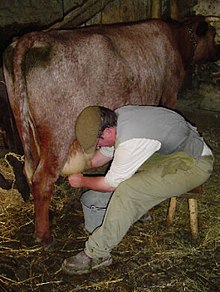House cow
 From Wikipedia the free encyclopedia
From Wikipedia the free encyclopedia

A house cow is a cow kept to provide milk for a home kitchen.[1] This differentiates them from dairy cows, which are farmed commercially. They can also provide manure, for use as a garden fertilizer,[2] and their offspring can be a source of meat.[3]
House cows are used in locations, usually rural, without convenient access to a supply of commercial dairy products.[4] They can also be kept for household self-sufficiency,[1] and a preference for organically farmed food.[2]
History[edit]
In England, during the 18th century, families would take their house cow, and other livestock, to graze on the local common land.[5] In the 1770s, before common land began to be enclosed as private land, it was estimated that even a 'poor' house cow, 'providing a gallon of milk per day' was worth, in the milking season, 'half the equivalent of a labourer's annual wage' to a family.[5]
Writing for an American audience in 1905, Kate Saint Maur asserted:
In fact, the country home without a cow, is like a coach without horses - so hopelessly stuck does the house keeper become who tries to provide a varied bill of fare without dairy produce. Away from city markets, a cow is a downright necessity.[4]
In 1910, during the United States' Presidency of William Howard Taft, Senator Isaac Stephenson had a house cow called 'Pauline Wayne', a Holstein Friesian,[6] sent from his Wisconsin farm to the White House to provide fresh milk for the first family.[7] After arrival she 'grazed contentedly upon the White House lot, oblivious to the general fuss being made'.[7]
In Australia, house cows were still common enough for the New South Wales government to issue a free booklet on their management and care in 1953.[8]
Popular breeds[edit]
In the 19th century, Breton cattle, from Brittany, France, were imported into England and promoted as an ideal house cow breed because of their docile nature and small size.[9]
Shetland cattle, from the Shetland Isles, off the north coast of Scotland, are a small, hardy cattle breed, which, until recent times, were traditionally milked three times a day—morning, twall (midday) and night—to produce the maximum amount of milk, which could be more than three gallons.[10]
The Dexter cattle breed, which originated in southwestern Ireland, is small, easy-to-keep and suited for milk and meat, is known as 'the poor man's house cow'.[11]
References[edit]
- ^ a b Grant, Rose (2012-12-10). "House cow revival in Tasmania". ABC Rural. Australian Broadcasting Corporation. Retrieved 2013-10-31.
- ^ a b "Keeping A House Cow". Warm Earth Organic Gardening. Warm Earth Publishing. 2003. pp. 34–38. Archived from the original on 2013-11-02. Retrieved 2013-10-31.
- ^ John Webster (2008-04-15). Animal Welfare: Limping Towards Eden. John Wiley & Sons. p. 131. ISBN 978-1-4051-7145-8.
- ^ a b Saint Maur, Kate V. (1905). A Self-Supporting Home. New York: The Macmillan Company. pp. 33–38. Retrieved 2013-10-31.
- ^ a b Fairlie, Simon (Summer 2009). "A Short History of Enclosure in Britain". The Land (7). Retrieved 2013-10-31.
- ^ "Life Of Pauline Wayne, White house Cow Insured". The Telegraph-Herald. 1911-08-17. Retrieved 2013-10-31.
- ^ a b "White house Cow Arrives". The Free Lancet. 1910-11-10. Retrieved 2013-10-31.
- ^ "The House Cow". The Land (Sydney, NSW : 1911 - 1954). Sydney, NSW: National Library of Australia. 27 March 1953. p. 38. Retrieved 31 October 2013.
- ^ Manwell, C., C.M.A (1987). "The Breton breed of cattle in Britain: extinction versus fitness" (PDF). The Agricultural History Review. 35: 171–179. Retrieved 2013-10-31.
- ^ "The House Cow". Shetland Cattle Herd Book Society. Archived from the original on 2013-11-02. Retrieved 2013-10-31.
- ^ "Traditional Food Skills For Tomorrow: Food Heritage In Living Memory" (PDF). Bord Bia (Irish Food Board). Archived from the original (PDF) on 2013-11-02. Retrieved 2013-10-31.